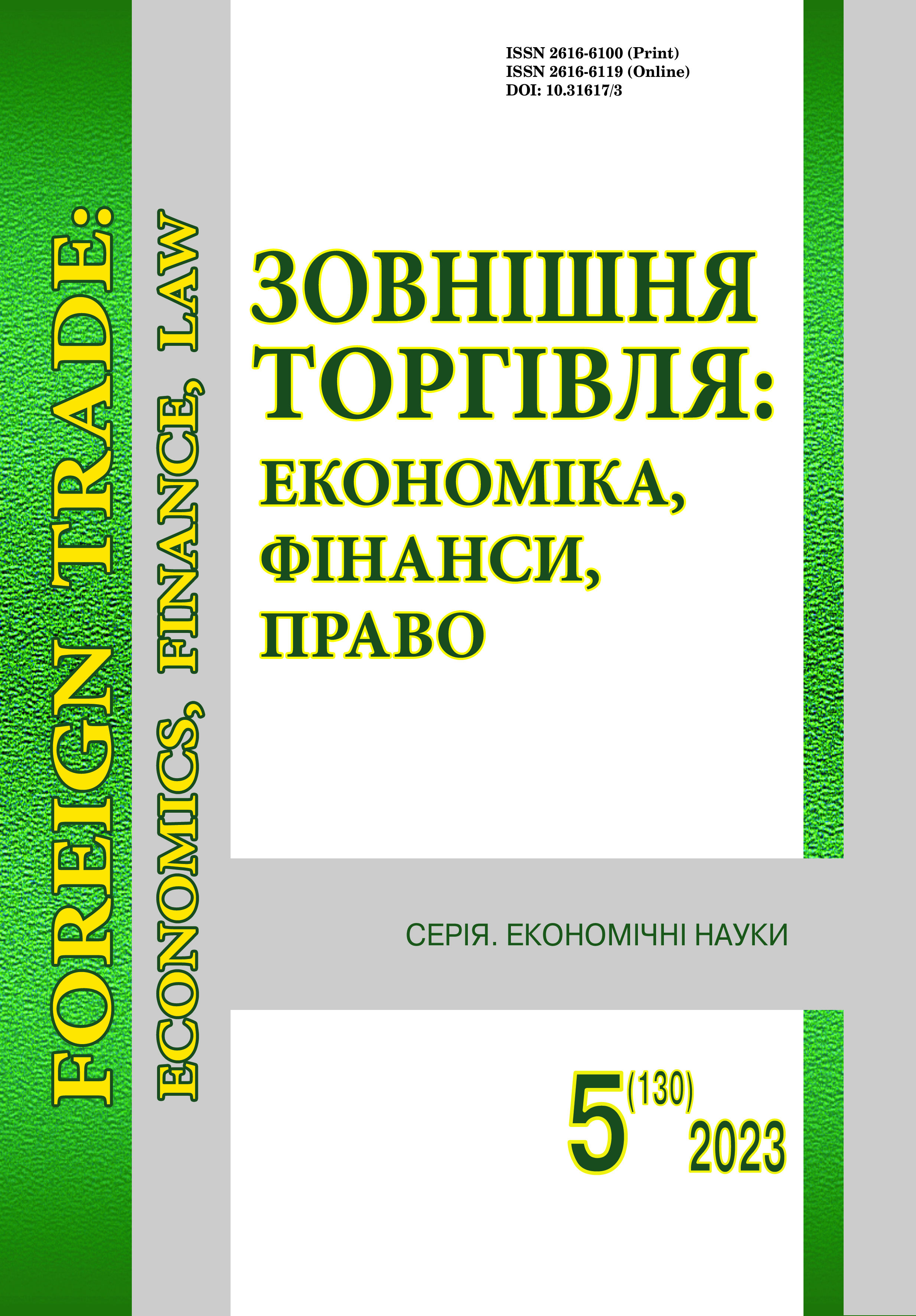Resilience of the EU and Ukraine economies in the conditions of russian aggression
DOI:
https://doi.org/10.31617/3.2023(130)05Keywords:
resilience of the economy, development, European Union, shock effects, war.Abstract
The brutal and inexplicable military aggression of Russia against Ukraine has caused the disruption of macroeconomic stability in our country. The war has led to immense human casualties and the loss of means of livelihood, placing a heavy burden on the economy and forcing millions of people to leave their homes. The longer the armed conflict is persisting, the more severe the consequences are becoming, not only for Ukraine but also for its partners, with the European Union being a key one. The functioning of the economy during wartime exacerbates the question of ensuring its resilience. The aim of this article is to identify macroeconomic shocks in the context of war, analyse the level of economic resilience in the EU and Ukraine, and justify directions for supporting the Ukrainian economy. General scientific methods were used, including theoretical generalization, comparative systemic analysis, systematization, statistical analysis, grouping, and scientific abstraction. In this research, the properties of economic resilience are described, specifically its capacity to avoid, withstand, and recover from the impact of shocks. Existing macroeconomic shocks of the war are identified, which have determined the trajectory of economic development for both Ukraine and the EU and influenced the level of resilience in their economies. Using approaches from the European Commission and the international company FM Global, the current level of economic resilience in the EU and Ukraine was determined. The war exhausts the resources of the national economy, making Ukraine incapable of independently and sufficiently mobilizing financial resources to counteract shock impacts. Conversely, the EU possesses significant resources, allowing it not only to maintain a sufficient level of economic resilience but also to assist Ukraine. Financial assistance from the EU remains a key source of ensuring the resilience of Ukraineʼs economy, enabling the implementation of measures to counter the current crisis and the shock impacts associated with it.
References
Opendatabot. (2023). Birth Rate in Ukraine. Decreased by 28% Since the Start of the Great War. https://opendatabot.ua/analytics/birth-crisis-2023
Boiko, A., Umantsiv, Yu., Cherlenjak, I. et al. (2022). Policy measures for economic resilience of Visegrad Group and Ukraine during the pandemic. Problems and Perspectives in Management, 20(2), 71-83. https://doi.org/10.21511/ppm.20(2).2022.07
Briguglio, L., Cordina, G., Farrugia, N., & Vela, S. (2009). Economic vulnerability and resilience concepts and measurements. Oxford Development Studies, 37(3), 229-247. https://doi.org/10.1080/13600810903089893
Bruneckiene, J. (2019). An Assessment of Socio-Economic Systemsʼ Resilience to Economic Shocks: The Case of Lithuanian Regions. Sustainability, (11), 1-24. https://ideas.repec.org/a/gam/jsusta/v11y2019i3p566-d199849.html https://doi.org/10.3390/su11030566
Caldera-Sаnchez, A. (2016). Strengthening economic resilience: insights from the post-1970 record of severe recessions and financial crises. OECD Economic Policy Paper, (20), 30. https://www.oecd.org/economy/growth/Strengthening-economic-resilience-insights-from-the-post-1970-record-of-severe-recessions-and-financial-crises-policy-paper-december-2016.pdf
Du, Y., Wang, Q., & Zhou, J. (2023). How does digital inclusive finance affect economic resilience: Evidence from 285 cities in China. International Review of Financial Analysis, (88). https://doi.org/10.1016/j.irfa.2023.102709
Economic Development Administration. Сeds content guidelines. content. Economic Resilience. https://www.eda.gov/ceds/content/economic-resilience.htm
Economic resilience in EMU (2017). European Commission. Directorate general economic and financial affairs. https://www.consilium.europa.eu/media/23535/eurogroup-15-september-item1-com-note-economic-resilience-in-emu.pdf
EU Solidarity with Ukraine. (2023). European Commission. https://eu-solidarity-ukraine.ec.europa.eu/eu-assistance-ukraine/recovery-and-reconstruction-ukraine_uk
FM Global Resilience Index. (2023). Research & Resources. FM Global. Johnston. https://www.fmglobal.com/research-and-resources/tools-and-resources/resilienceindex/explore-the-data/
Hallegatte, S. (2014). Economic resilience: definition and measurement. Policy Research working paper; no. WPS 6852. World Bank Group. http://documents.worldbank.org/curated/en/350411468149663792/Economic-resilience-definition-and-measurement https://doi.org/10.1596/1813-9450-6852
Lagutin, V., Boiko, A., & Shkuropadska, D. (2020). Institutional conditions for ensuring resilience of national economy: on the example of Ukraine. Baltic Journal of Economic Studies, 6(3), 76-86. https://doi.org/10.30525/2256-0742/2020-6-3-76-86
Lebedeva, L., Shtunder, I., Scherbakova, T., & Khrustalova, V. (2019). Estimation of resilience of ukrainian industry to shock influences: comparative analysis. EUREKA: Social and Humanities, (1), 20-34. https://doi.org/10.21303/2504-5571.2019.00816
National Bank of Ukraine website. (2023). https://bank.gov.ua
Official Yasno website. (2023). https://yasno.com.ua/
Petryk, O. (2022). Consequences of the war for the global economy and some European countries: Czechia. Vox Ukraine. https://voxukraine.org/naslidky-vijny-dlya-svitovoyi-ekonomiky-ta-okremyh-krayin-yevropy-chehiya
Retch, M. (1997). Social Structure of Accumulation Theory: Retrospect and Prospect. Review of Radical Political Economics, 29(3), 1-10. https://doi.org/10.1177/048661349702900301
Shynkorenko, T. (2010). Macroeconomic Shocks: Theoretical and Empirical Aspects. Economy and Forecasting, (2), 44-60.
Spring 2023. Economic Forecast: an improved outlook amid persistent challenges (2023). European Commission. https://economy-finance.ec.europa.eu/economic-forecast-and-surveys/economic-forecasts/spring-2023-economic-forecast-improved-outlook-amid-persistent-challenges_en
The Center for Economic Development Research. (2017). The National Association of Counties (NACO). What is Economic Resilience? https://cedr.gatech.edu/what-is-economic-resilience/
The website of LLC "Minfin Media". (2023). https://index.minfin.com.ua/ua/economy/index/inflation/2022
The World Bank. (2023). GDP per capita, PPP (current international $). http://data.worldbank.org/
Trading economics. (2023). Statistics. https://tradingeconomics.com/world/food-price-index
Ukraine Recovery Conference. (2023). https://ua.urc-international.com/
Ukraine War Economy Tracker. (2023). Center for Economic Strategy. https://ces.org.ua/tracker-economy-during-the-war/
Vyshlinsky, H., Myhajlyshyna, D., & Samojljuk, M. (2023). Ukrainian refugees: who are they, where did they come from and how to return them? Center for Economic Strategy. https://ces.org.ua/who-are-ukrainian-refugee-research/
Wenqi, D., Madasi, J. D., Khurshid A., & Ma, D. (2022) Industrial structure conditions economic resilience Technological Forecasting and Social Change. Vol. 183. https://doi.org/10.1016/j.techfore.2022.121944
Zeev, N. B., Ifergane, T. (2022). Firing restrictions and economic resilience: Protect and survive? Review of Economic Dynamics, (43). https://doi.org/10.1016/j.red.2021.01.003
Additional Files
Published
How to Cite
Issue
Section
License

This work is licensed under a Creative Commons Attribution 4.0 International License.
This work is licensed under a Creative Commons Attribution 4.0 International (CC BY 4.0)
Funding data
-
European Commission
Grant numbers Erasmus+ project: 101083497 — EUERP — ERASMUS-JMO-2022-HEI-TCH-RSCH "EU Economic Resilience Policy"







